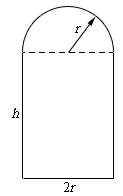An arched window (an upper semi-circle and lower rectangle) has a total perimeter of #10 \ m#. What is the maximum area of the window?
1 Answer
The maximum area is
radius of the semicircle is
#10/(4 + pi) #
rectangular window is#10/(4+pi) xx 10/(4 + pi) (~~ 1.400 xx 1.400)#
Explanation:
Let us setup the following variables:
# { (r, "Radius of the semicircle","(m)"), (h=L, "Height of the rectangular window","(m)"), (A, "Total area enclosed by the window", "(sq m)") :} #
Our aim is to find
The total perimeter is that of
# 10 = (h + 2r + h) + (1/2)(2pir) #
# \ \ \ = 2r + 2h + pi r #
# :. 2h = 10 - 2r - pi r #
# :. \ \ h = 1/2(10 - 2r - pi r) #
And the total Area is that of a rectangle and a semicircle:
# A = (h)(2r) + (1/2)(pir^2) #
# \ \ \ = 2hr + 1/2 pi r^2 #
# \ \ \ = 2(1/2(10 - 2r - pi r))r + 1/2 pi r^2 #
# \ \ \ = 10r - 2r^2 - pi r^2 + 1/2 pi r^2 #
# \ \ \ = 10r - 2r^2 - 1/2 pi r^2 #
We now have the Area,
# (dA)/(dr) = 10 - 4r - pi r #
At a critical point we have
# 10 - 4r - pi r = 0 #
# :. \ \ \ \ 4r + pi r = 10 #
# :. \ \ \ r(4 + pi) = 10 #
# :. \ \ \ \ \ \ \ \ \ \ \ \ \ \ \r = 10/(4 + pi) (~~ 1.400)#
With this value of
# A = 10(10/(4 + pi)) - 2(10/(4 + pi))^2 - 1/2 pi (10/(4 + pi))^2 #
# \ \ \ = 50/(4 + pi) (~~ 7.001)#
And:
# h = 1/2(10 - 2(10/(4 + pi)) - pi (10/(4 + pi))) #
# \ \ = 10/(4+pi) (~~ 1.400)#
We can visually verify that this corresponds to a maximum by looking at the graph of
graph{10x - 2x^2 - 1/2 pi x^2 [-5, 10, -5, 22]}
And also check that the perimeter is correct:
# P = 2r + 2h + pi r #
# \ \ = 2(10/(4 + pi)) + 2(10/(4 + pi)) + pi(10/(4 + pi)) #
# \ \ = 10 #


